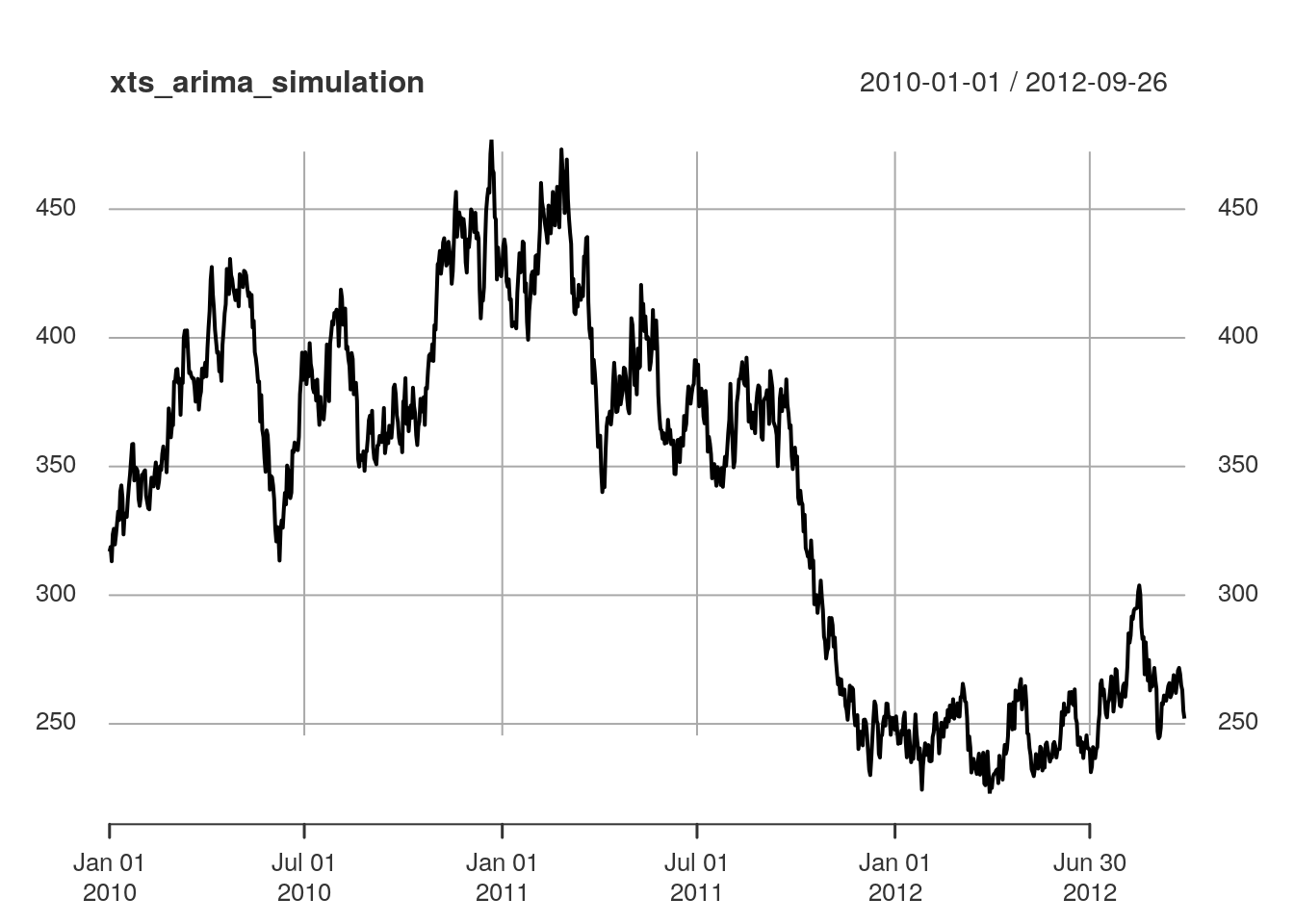Creating simulated data from a time series model in R
Introduction
This post discusses how to simulate data with similar statistical properties to a real financial time series. This is useful if you have a limited data source and you wish to generate more data in order to reduce the likelihood of overfitting. By generating multiple different time series all with similar statistical properties, you can optimise your trading strategy on thousands of datasets and choose the parameters which have the best results.
We will be using “AAPL” (Apple) for this example and will apply an ARIMA model on our data which will in turn be used to simulate some data.
The packages you will need are as follows:
install.packages("quantmod")
install.packages("forecast")
# If you already have them installed you can use the following:
library(quantmod)
library(forecast)
Download your data
In order to create a model we need some data, we will use Apples stock price which can be retrieved using the Quantmod package and the ticker for Apple which is AAPL, for your own project you can use any time series you wish.
getSymbols("AAPL")
## [1] "AAPL"
head(AAPL)
## AAPL.Open AAPL.High AAPL.Low AAPL.Close AAPL.Volume AAPL.Adjusted
## 2007-01-03 12.32714 12.36857 11.70000 11.97143 309579900 10.36364
## 2007-01-04 12.00714 12.27857 11.97429 12.23714 211815100 10.59366
## 2007-01-05 12.25286 12.31428 12.05714 12.15000 208685400 10.51822
## 2007-01-08 12.28000 12.36143 12.18286 12.21000 199276700 10.57016
## 2007-01-09 12.35000 13.28286 12.16429 13.22429 837324600 11.44823
## 2007-01-10 13.53571 13.97143 13.35000 13.85714 738220000 11.99609
Model our data
We want to create a statistical model which has a good fit to our time series. We will achieve this by using the Arima function from the forecast package which will allow us to create a number of models and then choose the one that we deem to be the best fit. We will determine the best fit based on the AIC (Akaike Information Criterion) value, choosing the model with the smallest value.
Note that the snipper of code below has been taken from the Quantstart blog and tweaked to fit my project, the link to the full article containing the original code can be found in the references.
One of the key differences I have made is using the “Arima” function and supplying my data to the model without using the differenced log of the close price to transform it to stationary. Instead, I have used the argument lambda = 0 in my call to “Arima” which applies the Box-Cox transformation, this is also applied when simulating my data which has prevented the stock prices from dropping below 0, which wouldn’t occur in the marketplace.
# Before running our loop we create two objects which will contain the model with the best fit
final.aic <- Inf
final.order <- c(0,0,0)
# We use a loop to run through all the combinations of our ARMA model, where p represents the autoregressive part of our model and q represents our moving avaerage part
for (p in 0:5) for (q in 0:5) {
if ( p == 0 && q == 0) {
next
}
arimaFit = tryCatch( Arima(AAPL$AAPL.Close, order=c(p, 0, q), lambda = 0),
error=function( err ) FALSE,
warning=function( err ) FALSE )
if( !is.logical( arimaFit ) ) {
current.aic <- AIC(arimaFit)
if (current.aic < final.aic) {
final.aic <- current.aic
final.order <- c(p, 0, q)
final.arima <- Arima(AAPL$AAPL.Close, order=final.order, lambda = 0)
}
} else {
next
}
}
print(final.order)
## [1] 3 0 5
Simulating our data
The next step is to use the model that we chose above to generate simulated data which we can later use for our backtesting.
numberofobservations <- 1000 # can be any number you wish
set.seed(1) # this is purely for this demonstration, remove this if you are simulating data otherwise you'll get the same price series each time.
arima_simulation <- simulate(final.arima, nsim = numberofobservations, lambda = 0)
head(arima_simulation)
## Time Series:
## Start = 3377
## End = 3382
## Frequency = 1
## [1] 316.9825 318.7347 313.1725 323.6708 325.7969 319.7002
Tidying and plotting the output
The periodicity of your data will determine the time between intervals that you enter in the “by =” argument below. For this example we are using the daily close of AAPL, therefore we use “day”, if we had minute data we would use “min”. The purpose of this step is to get our data into a suitable format before backtesting. The first object index_ts is a vector of dates which we will use as the index for our data when we create an xts object.
index_ts <- seq(from=as.POSIXlt("2010-01-01 00:00:00"), by = "day", length.out = numberofobservations)
xts_arima_simulation <- xts(arima_simulation, order.by = index_ts)
names(xts_arima_simulation) <- "close"
plot(AAPL$AAPL.Close, type="l")

plot(xts_arima_simulation, type="l")

Conclusion
This has been a very quick demonstration on how to model a time series and generate some simulated data from it. If you would like some further information I have added a number of links in the section below.
References and reading material
Quantstart
The article linked below has some of the code for finding the best fitting ARIMA model.
https://www.quantstart.com/articles/ARIMA-GARCH-Trading-Strategy-on-the-SP500-Stock-Market-Index-Using-R/
Rob J Hyndman and George Athanasopoulos ,Forecasting: Principles and Practice
This is an online textbook written by the authors of the forecast package and contains information on ARIMA models in more detail amongst many other topics.
https://otexts.com/fpp2/arima.html